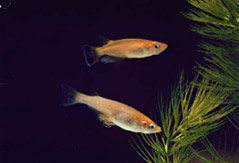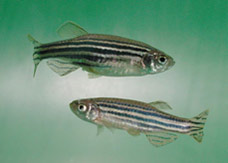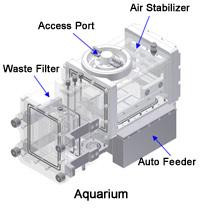This is an archive of information released in the past.
Disclaimer: It may contain broken links or outdated information. Some parts may not function in current web browsers.
*Visit https://humans-in-space.jaxa.jp/en/ for the latest information.

Experiment
- News
- Kibo Utilization Strategy
- Kibo Utilization Plan
- List of JAXA's Utilization Themes
- Experiment Facilities
- Space Environment Utilization
- Archive
AQH Outline
Aquatic Habitat (AQH) will have the capabilities to accommodate small freshwater fish, medaka or zebrafish, which have many advantages as vertebrate model. The AQH will be installed in Japanese Experiment Module (Kibo) of ISS and will be utilized for the experiments to investigate how microgravity and the space radiation environment, particularly over the long term, affect living things including human being.
The AQH is composed of one closed water circulation system with two aquariums. The aquarium has automatic feeding system, LED light for day/night cycle and CCD camera for observation. The aquarium environment will be maintained by water flow rate control, water temperature control, dissolved gas exchange with air, and biological/physical filtrations. Also, the AQH will have on-orbit maintenance capabilities, such as water quality check, water exchange, waste filter replacement and so on, to achieve long-term experiments up to 90days.
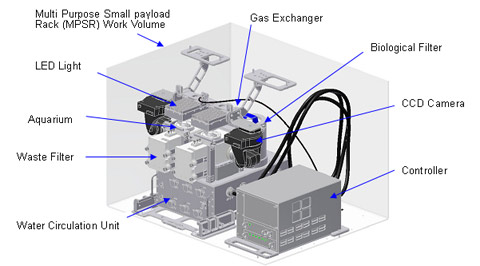
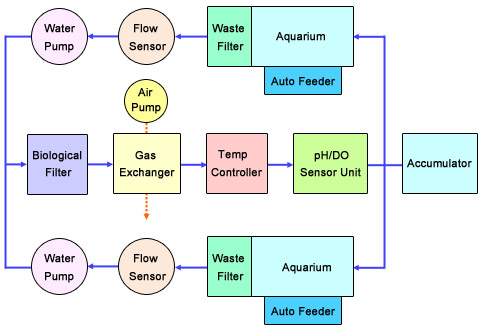
AQH Water Flow Diagram
AQH Major Specifications
- Experiment duration
Up to 90 days - Water circulation system
One closed water loop with two aquariums
Total water volume: 3.2 L - Aquarium
Inner dimensions: 150 X 70 X 70mm
Inner water volume: 0.7 L/aquarium
Air Stabilizer is equipped for air/water interface control and Access Port is equipped for fish sampling - Water temperature control
Water temperature range: 25-30 degC
Water temperature accuracy: ±1 degC of set point - Water flow rate control
Water flow rate can be controlled for each aquarium
Water flow rate range: 0-0.5 L/min
Water flow rate accuracy: ±10 % of set point - O2 supply/CO2 removal
Gas exchange with air by artificial lung (gas permeable membrane) - Water quality maintenance
Biological filter with nitrifying bacteria for NH4/NO2 removal
Water exchange for NO3 removal
Physical filter with activated carbon for waste trap and organic material adsorption - Day/night cycle
Two LED lights for each aquarium
Light intensity: selectable in the range of 0-1000 Lux
Light/dark cycle: selectable within total 24 hrs - Automatic feeding
Artificial powdery food can be used
Feeding amount and timing are programmable according to fish developmental stages
Feeding frequency: maximum 3 times/day - Observation
Two CCD cameras for each aquarium
Infrared camera observation is available - Data monitor
Water temperature, water flow rate, water pressure, dissolved oxygen, pH, lighting status, eeding status - Commanding
Water temperature set point, water flow rate set point, lighting control, feeding control, CCD amera control - Fish Transportation Container
Container for fish transportation from launch site to ISS - Fish Catcher
Apparatus to catch fish in the aquarium and took out for chemical treatment or generational change - Fish Fixation Kit
Kit to fix fish or treat fish chemically and retrieve for post-flight analysis - Egg Collection/Hatching Kit
Kit to collect medaka eggs in the aquarium and maintain them until hatch for multi-generational experiment - Water Quality Test Kit
Kit to check NH4, NO2, NO3 concentrations of sampled AQH circulation water - Water Exchange Kit
Kit to exchange AQH circulation water

AQH Accessories
The AQH will have various accessories for fish transportation to ISS, fish sampling and preservation for post-flight analysis, generational separation and change for supporting medaka multi-generational experiment and also AQH maintenance.
AQH Operations
The AQH main components will be transported to ISS by HⅡ Transfer Vehicle (HTV) from Tanegashima Space Center in Japan. Only living samples such as fish will be transported by Soyuz or Progress from Baikonur Cosmodrome due to their late loading requirements. Samples for post-flight analysis will be retrieved by Soyuz Descent Module.
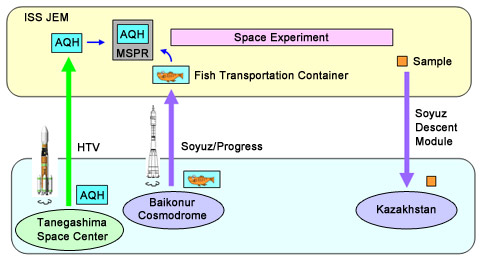
| Copyright 2007 Japan Aerospace Exploration Agency | Site Policy |
